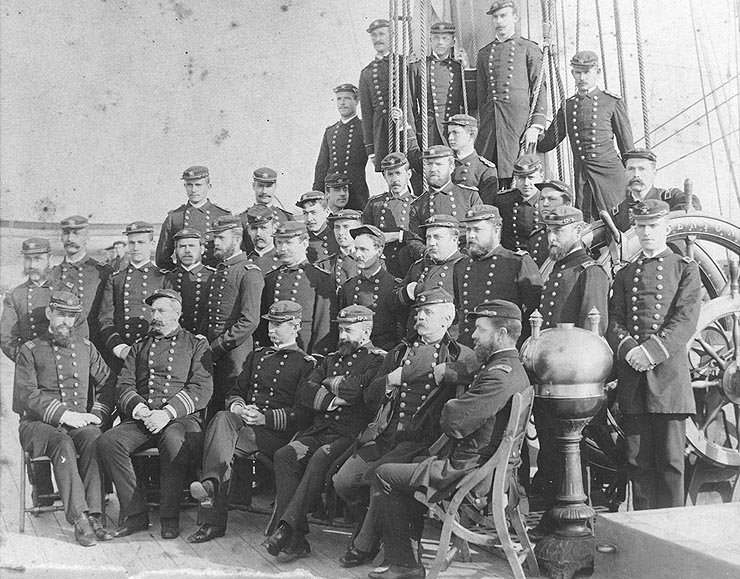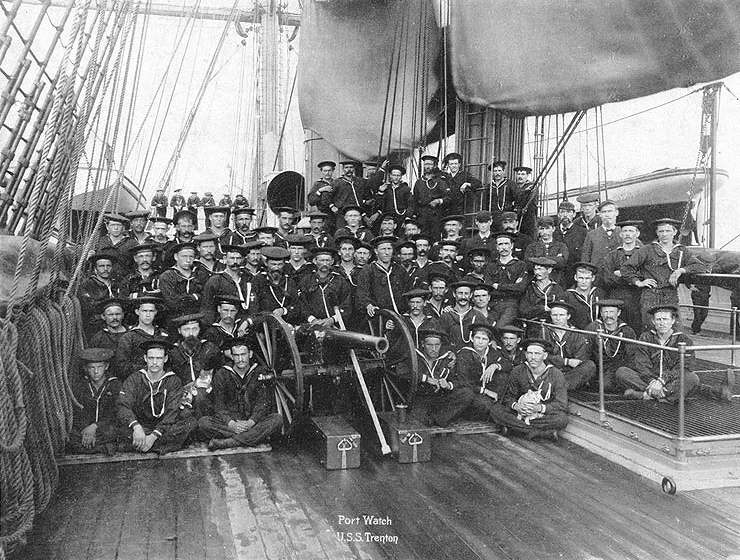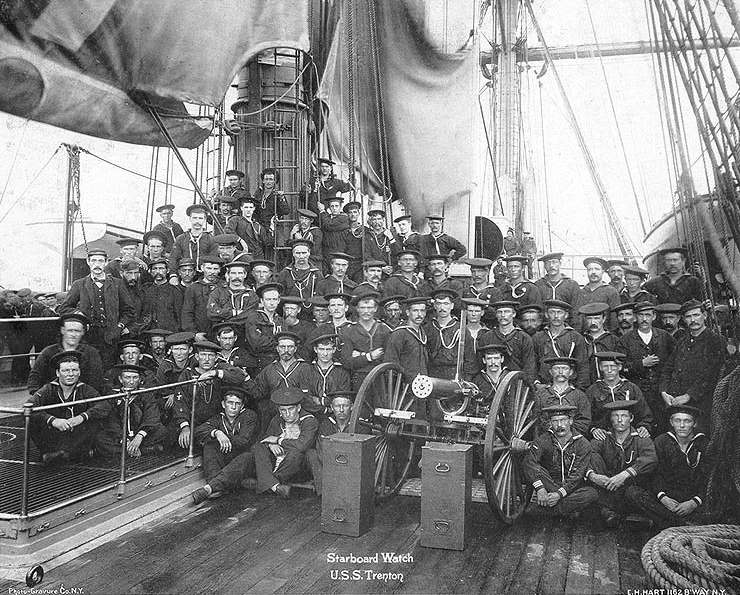
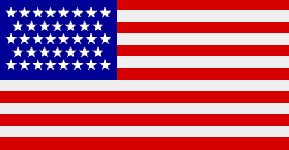
The data here is generally gleaned from published sources. In one or two instances, personal descendants have e-mailed with data, or another researcher interested in the story of the storm. In all cases, the information presented here is given in good faith but should not be considered as factual without independent verification.
If you have any data, and especally images, of USS Trenton's crew and you would like to share this with the world, or at least, those interested in the Samoa Hurricane, please feel free to contact me.The images are from American Naval History and Heritage Command unless attributed elsewhere.
Please Note: Any visitors to this site who object to the images of family members being portrayed, please contact me and I will remove the images, and/or the details, immediately.
Where there is a photograph of a crew member, please DO NOT use the image for anything at all, without first asking my permission using the contact form. If I do not know the family contact, then I will not be able to give permission for its use. If I do know of a family contact, I will ask them if they give permission, so in the contact form, please give details of how and why you wish to use the image. If they are agreeable, or indeed if not, I will then reply to your enquiry. This is not intended to be awkward or unfriendly, I think it is simply good courtesy to ask first.
If you are an American visitor to this page, please take the time to visit the page The Men Who Perished on which appears an image of the American Flag. It is intended to be the version of the flag flown on the American ships at the time of Samoa in 1889. I wish to be sure that the version I have chosen (from many versions I found on the web!) to be the correct one, and any help I could be given would be gratefully received. It is described as the "38-Star Navy Ensign, valid 1877 to 1890". I have included a small image at the top of this page. If you think I might have got it wrong, please contact me and let me know! I am British and am not sure about these American things.
Quick links:
He was a key person in the rescue of personnel of the Vandalia. Some 9 years later he was Officer of the Deck when the USS Maine blew up in Havana Harbor, Cuba, on Feb. 15, 1898, just 2 weeks after he was made Lieutenant. He died 5 months later from the blow that he received on that occasion. He is recorded in the Naval Historical Centre records as having survived the Maine explosion. His service record is: Cadet Midshipman, 28 June, 1878. Ensign, 1 July, 1884. Lieutenant, Junior Grade, 31 July, 1894. Lieutenant, 1 February, 1898. Died 16 July, 1898. He is mentioned by Hoyt in "The Typhoon That Stopped a War" on p. 69.
Details courtesy of Prof. Herman de Haas and the American Naval History and Heritage Command, page now removed.
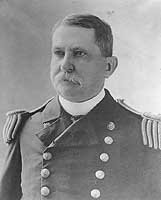 Norman von Heidreich Farquhar was born in Pottsville, Pennsylvania, on 11 April 1840 and attended the U.S. Naval Academy during 1854-59. After graduation, he served with the Africa Squadron until September 1861 suppressing the slave trade, and was a Midshipman and Acting Master, 1859-61. He brought to the United States the captured slaver the Triton, with a crew of ten men and no other officer to assist him. Lieutenant Farquhar spent most of the Civil War off the U.S. Atlantic coast and in the West Indies, serving in the gunboats Mystic, Sonoma and Mahaska and the cruisers Rhode Island and Santiago de Cuba. He was promoted to the rank of Lieutenant Commander in mid-1865, a few months after the fighting ended, and was on duty at the U.S. Naval Academy from then until September 1868. For the rest of the 1860s and into the next decade, Farquhar served in the warship Swatara, was Executive Officer of USS Severn and USS Powhatan and Commanding Officer of USS Kansas. He also had two tours at the Boston Navy Yard on ordnance duty and as Executive Officer.
Norman von Heidreich Farquhar was born in Pottsville, Pennsylvania, on 11 April 1840 and attended the U.S. Naval Academy during 1854-59. After graduation, he served with the Africa Squadron until September 1861 suppressing the slave trade, and was a Midshipman and Acting Master, 1859-61. He brought to the United States the captured slaver the Triton, with a crew of ten men and no other officer to assist him. Lieutenant Farquhar spent most of the Civil War off the U.S. Atlantic coast and in the West Indies, serving in the gunboats Mystic, Sonoma and Mahaska and the cruisers Rhode Island and Santiago de Cuba. He was promoted to the rank of Lieutenant Commander in mid-1865, a few months after the fighting ended, and was on duty at the U.S. Naval Academy from then until September 1868. For the rest of the 1860s and into the next decade, Farquhar served in the warship Swatara, was Executive Officer of USS Severn and USS Powhatan and Commanding Officer of USS Kansas. He also had two tours at the Boston Navy Yard on ordnance duty and as Executive Officer.Details originally courtesy of American Naval History and Heritage Command, page now apparently removed. See Arlington National Cemetary web-site.
This man's heroism appears in a series of reports which exist in condensed form in the Report of the Secretary of the Navy for 1889, as well as the Record of Life Saving Medals Awarded, 1876-1944. In the plainest terms, Mr. Hachitaro dove into the storm-swept water from his ship to rescue an officer from USS Vandalia who had fallen overboard. In the language of military honors, Mr. Hachitaro acted, “...at great peril to his life, as the sea was running high, the ships rolling violently, and the main-mast to which the officer clung, was in danger of being carried away at any moment. It was actually carried away soon after he was taken off.”
The above text is taken directly from the Master's Thesis being compiled by an American researcher Tyler G. Miller at Norwich University, Northfield, Vermont, with his kind permission. Tyler has carried out extensive research into the political background to the situation in Samoa, and intends to carry out further research on this interesting gentleman, so watch this space!
One of the African American sailors standing near the starboard "bridle port" when it was stove in by a massive sea and was killed instantly by the force of the blow at around 8.0 a.m. on the 16th March.
His body was repatriated to the United States in June, 1891, and buried with 18 others in a row at the Mare Island Navy Cemetery.
Sources: The Los Angeles Herald, 31 March 1889, Edwin P Hoyt, "The Typhoon That Stopped a War"; p.128 and San Francisco Call, Volume 70, Number 25, 25 June 1891.
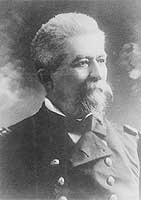 Lewis Ashfield Kimberly was born in Troy, New York on 2 April 1830. He was appointed a Midshipman in the U.S. Navy in December 1846 and served off Africa in the sloop Jamestown in 1847-50. He was in the Pacific on board the frigate Raritan during 1850-52, then returned to African waters in the sloops Decatur and Dale in 1853-1856. During the remainder of the decade and in the early 1860s, Lieutenant Kimberly was stationed at the Boston Navy Yard, in the East Indian Squadron with USS Germantown, and in the Mediterranean in USS Richmond. His Civil War service included duty with USS Potomac in the Gulf of Mexico in 1861-62 and extensive combat experience on board USS Hartford on the Mississippi River in 1863 and at Mobile Bay in 1864.
Lewis Ashfield Kimberly was born in Troy, New York on 2 April 1830. He was appointed a Midshipman in the U.S. Navy in December 1846 and served off Africa in the sloop Jamestown in 1847-50. He was in the Pacific on board the frigate Raritan during 1850-52, then returned to African waters in the sloops Decatur and Dale in 1853-1856. During the remainder of the decade and in the early 1860s, Lieutenant Kimberly was stationed at the Boston Navy Yard, in the East Indian Squadron with USS Germantown, and in the Mediterranean in USS Richmond. His Civil War service included duty with USS Potomac in the Gulf of Mexico in 1861-62 and extensive combat experience on board USS Hartford on the Mississippi River in 1863 and at Mobile Bay in 1864.Details originally courtesy of American Naval History and Heritage Command.
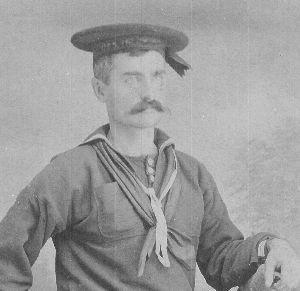 Charles H. Stoddard was a machinist on the USS Saratoga and USS Trenton. He is buried in Thomaston, Maine, USA beside his father Seth Stetson Gerry, who was a shipbuilder and ship's captain. A letter from his uncle to his mother dated October 14, 1891 notes that he had been suffering for some time. His obituary in the newspaper noted, "His death was due to hardships he endured on the occasion of the hurricane hitting U.S.S. steamship Trenton at Samoa March 15-16, 1889."
Charles H. Stoddard was a machinist on the USS Saratoga and USS Trenton. He is buried in Thomaston, Maine, USA beside his father Seth Stetson Gerry, who was a shipbuilder and ship's captain. A letter from his uncle to his mother dated October 14, 1891 notes that he had been suffering for some time. His obituary in the newspaper noted, "His death was due to hardships he endured on the occasion of the hurricane hitting U.S.S. steamship Trenton at Samoa March 15-16, 1889."
Image and details courtesy of Clare L. Bromley.
| W.H. Allen | Lieutenant | |
| G. Bart | Seaman | Broken Leg |
| Blanden (J.J. Blandin?) | Ensign | Later Lieutenant |
| S. H. Boutwell | Lieutenant | |
| J. Brady | Pay Clerk | |
| Brown | Sailmaker | |
| A. J. Clark | Pay Inspector | |
| B. C. Decker | Naval Cadet | Injured in fall to the deck |
| N. von H. Farquhar | Captain | Later Rear-Admiral |
| B. C. Fernald | Carpenter | |
| Galt | Past. Assistant Engineer | |
| W. Gibson | Coal Heaver | Scalded |
| S. L. Graham | Lieutenant | |
| F. Hachitaro | Cabin Steward | |
| E. Hendrickson | Lieutenat | |
| J. Hewlett | Landsman | Killed |
| R.W. Huntington | Captain of Marines | Later Colonel |
| L.A. Kimberly | Rear-Admiral | |
| H. W. Lyon | Lieutenant-Commander | |
| H. Main | Past. Assistant Engineer | |
| C. H. Matthews | Engineer | |
| A. A. McAllister | Chaplain | |
| J. McLaughlin | Boatswain | |
| G. A. Merriam | Lieutenant | |
| J. Nicholls | Corporal of Marines | Accidentally killed in Apia 4 May 1889 |
| F. Noefleet | Past. Assistant Surgeon | |
| L. L. Reamy | Lieutenant | |
| B. Ricklin | Seaman | Accidentally killed in Apia 10 June 1889 |
| H. Rittenhouse | Lieutenant | |
| J. E. Rostedt | Ordinary Seaman | Broken Leg |
| B. O. Scott | Lieutenant | |
| C. H. Stoddard | Machinist | |
| H. J. Tressett | Acting Gunner | |
| J. Westfall | Acting Gunner | |
| Dr. C. A. White | Doctor of Pacific Station | |
| S. S. White | Doctor of Pacific Station |
Sources: JP Dunning account dated February 1890 (Do a "FIND" for Samoa); Admiral Kimberly's Special Report dated 16th April, 1889; Alexandria Gazette, 19 August 1889; Daily Alta California, 7 July 1889. Various family members.
